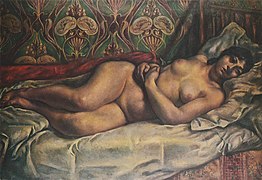Yasui Sōtaro

Yasui Sōtarō ( Japanese 安井 曾 太郎 ; * May 17, 1888 in Kyōto ; † December 16, 1955 in Yugawara , Kanagawa Prefecture ) was a Japanese painter of the Yōga direction.
life and work
Yasui was the son of a wool products wholesaler in Kyoto. He broke off training at the "Kyoto City Commercial School" and began his artistic training at the private "Shōgoin Yōga Kenkyūjo" ( 聖 護 院 洋 画 研究所 , German "Shōgoin Research Institute for Western Painting"). Then moved to the Kansai Art Academy ( 関 西 美術 院 , Kansai bijutsu-in ), where he was one of the students of Asai Chū and Kanokogi Takeshirō . In 1907 he went to Paris and studied for three years at the Académie Julian under the history painter Jean-Paul Laurens . His drawings and paintings received so many awards that people talked about them for a long time. When the First World War broke out in 1914, Yasui fell ill and returned to Japan.
In 1905 Yasui joined the Nika-Kai artists' association, which showed 44 paintings by him in an exhibition, including "The Face of a Woman" ( 女 の 顔 , Onna no kao , 1912), "Woman with Black Hair" ( 黒 き 髪 の 女 , Kuroki kami no onna ; 1913), "Woman who washes her feet" ( 足 を 洗 う 女 , Ashi o arau onna ; 1913) and "Peacock and woman" ( 孔雀 と 女 , Kujaku to onna ; 1914). His work was stimulating for Japanese artists, while he was now looking for his style in the Japanese environment, which he finally succeeded in 1929 with the painting "Sitzende" ( 座像 , Zazō ). Then he painted a whole series of portraits, landscapes and still lifes.
In 1935 he became a member of the Imperial Academy of Arts, whereupon he left the Hika-kai. In 1936 Yasui founded the artist group Issui-kai ( 一 水 会 ) together with other artists .
In his portraits in the 30s he tried to strike a balance between observation and artistic deformation, like the "Portrait Dr. T." ( T 先生 の 像 ), "Portrait Jin Rong" ( 金蓉 ) show. He finally succeeded with the "Portrait Fukai Eigo" ( 深井 英 五 氏 像 , Fukai Eigo-shi zō ; 1937). His landscapes followed a similar development, as the comparison of "Lama Temple of Chengde " ( 承 徳 の 喇嘛廟 , Shōtoku no rama-byō ; 1937) with the Kamikochi ( 上 高地 ) landscapes show.
In 1944 Yasui was recognized as an "artist at the imperial court" ( 帝室 技 芸 員 , Teishitsu gigei-in ) and was appointed teacher at the "Tokyo bijutsu gakkō". So he stayed active in training young artists. In his final years, he retired to Yugawara in Kanagawa Prefecture , where he further simplified his style in the midst of nature. In 1952 he was awarded the Order of Culture .
A collection of his writings was published posthumously under the title "With the Eyes of an Artist" ( 画家 の 目 , Gaka no me ).
Appreciation
Initially, Yasui's work was first under the influence of Gustave Courbet and later also that of Cézanne . After he returned to his homeland, he continued to paint in the western style, but freed himself from the influence of French painting and developed his own visual language. Yasui is best known for his portraits.
photos
Remarks
- ↑ A name that is typical for Japan: They met regularly on the first (一) Wednesday ( 水 [曜 日] ) of the month.
- ↑ Fukai Eigo (1871–1945) was the 13th President of the Bank of Japan .
Individual evidence
- ↑ Yem Yayin (Yapi-Endüstri Merkezi Yayinlari) (ed.): Eczacibaşi Sanat Ansiklopedisi. (German: Ezacibaşi Kunstenzyklopädie. ) 3rd edition. 1997, ISBN 975-7438-54-5 , p. 1926. (Turkish)
literature
- Japan Foundation (Ed.): Japanese Painting in the Western Style, 19th and 20th Centuries. Exhibition catalog, Cologne, 1985.
- Tazawa, Yutaka: Biographical Dictionary of Japanese Art . Kodansha International, 1981. ISBN 0-87011-488-3 .
- Tomiyama, Hideo: Yasui Sotaro In: Gendai Nihon Bijutsu Zenshu, Volume 10. Shueisha, 1972.
Web links
| personal data | |
|---|---|
| SURNAME | Yasui, Sōtaro |
| ALTERNATIVE NAMES | 安井 曾 太郎 (Japanese) |
| BRIEF DESCRIPTION | Japanese painter |
| DATE OF BIRTH | May 17, 1888 |
| PLACE OF BIRTH | Kyoto |
| DATE OF DEATH | December 16, 1955 |
| Place of death | Yugawara , Kanagawa Prefecture |






